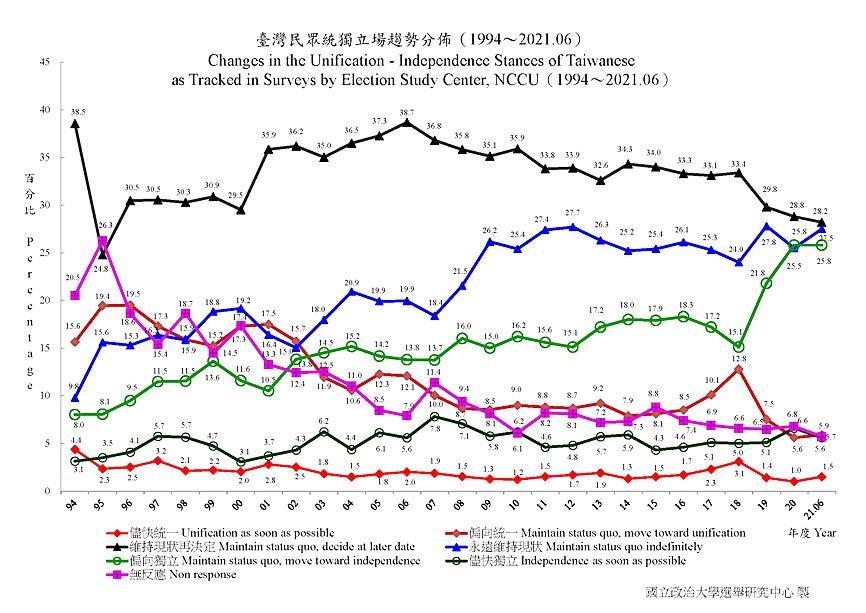Self-identification as “Taiwanese and Chinese,” or solely as “Chinese,” has dropped to record lows, while 63.3 percent of the public regard themselves as Taiwanese, a survey released on Tuesday by National Chengchi University’s Election Study Center showed.
Respondents identifying as Taiwanese and Chinese dropped to 31.4 percent, while those identifying solely as Chinese fell to 2.7 percent, the survey showed.
The results reflect changes in attitudes since 1994 among Taiwanese toward independence and unification with China, as well as self-identification trends since 1992, commenters said.

Screen grab from the Web site of National Chengchi University’s Election Study Center
Support for independence was 25.8 percent, while about 5 percent of respondents said that they want the nation to “declare independence as soon as possible,” the survey showed.
Support for the “status quo” in the Taiwan Strait was 28.2 percent, while 27.5 percent said they would prefer that the “status quo” be permanent, the survey showed.
The results showed that 1.5 percent of respondents want “unification with China as soon as possible,” while 5 percent said that they leaned toward unification.
Democratic Progressive Party (DPP) Legislator Hsu Chih-chieh (許智傑) yesterday said that Chinese oppression of Hong Kong’s democracy and Taipei’s successful efforts to increase interactions with the international community under the name Taiwan contributed to the increase in people who self-identify as Taiwanese.
The Chinese Nationalist Party (KMT) should abandon its outmoded adherence to the so-called “1992 consensus” and dreams of “uniting China,” Hsu said.
The “1992 consensus” — a term that former Mainland Affairs Council chairman Su Chi (蘇起) admitted making up in 2000 — refers to a tacit understanding between the KMT and the Chinese government that both sides acknowledge there is “one China,” with each side having its own interpretation of what “China” means.
The Election Study Center has been conducting polls on the issue of national identification for a long time and its findings should be considered credible, DPP Legislator Chen Ting-fei (陳亭妃) said.
The results show that the oppressive tactics adopted by Beijing — fighter jets circumnavigating Taiwan, oppressing Hong Kong and oppression of Uighurs — not only fail to intimidate Taiwanese, but bolster their belief and self-identification as Taiwanese, Chen said.

Beijing could eventually see a full amphibious invasion of Taiwan as the only "prudent" way to bring about unification, the US Department of Defense said in a newly released annual report to Congress. The Pentagon's "Annual Report to Congress: Military and Security Developments Involving the People's Republic of China 2025," was in many ways similar to last year’s report but reorganized the analysis of the options China has to take over Taiwan. Generally, according to the report, Chinese leaders view the People's Liberation Army's (PLA) capabilities for a Taiwan campaign as improving, but they remain uncertain about its readiness to successfully seize

Taiwan is getting a day off on Christmas for the first time in 25 years. The change comes after opposition parties passed a law earlier this year to add or restore five public holidays, including Constitution Day, which falls on today, Dec. 25. The day marks the 1947 adoption of the constitution of the Republic of China, as the government in Taipei is formally known. Back then the Chinese Nationalist Party (KMT) governed China from Nanjing. When the KMT, now an opposition party in Taiwan, passed the legislation on holidays, it said that they would help “commemorate the history of national development.” That

Taiwan has overtaken South Korea this year in per capita income for the first time in 23 years, IMF data showed. Per capita income is a nation’s GDP divided by the total population, used to compare average wealth levels across countries. Taiwan also beat Japan this year on per capita income, after surpassing it for the first time last year, US magazine Newsweek reported yesterday. Across Asia, Taiwan ranked fourth for per capita income at US$37,827 this year due to sustained economic growth, the report said. In the top three spots were Singapore, Macau and Hong Kong, it said. South

Snow fell on Yushan (Jade Mountain, 玉山) yesterday morning as a continental cold air mass sent temperatures below freezing on Taiwan’s tallest peak, the Central Weather Administration (CWA) said. Snowflakes were seen on Yushan’s north peak from 6:28am to 6:38am, but they did not fully cover the ground and no accumulation was recorded, the CWA said. As of 7:42am, the lowest temperature recorded across Taiwan was minus-5.5°C at Yushan’s Fengkou observatory and minus-4.7°C at the Yushan observatory, CWA data showed. On Hehuanshan (合歡山) in Nantou County, a low of 1.3°C was recorded at 6:39pm, when ice pellets fell at Songsyue Lodge (松雪樓), a